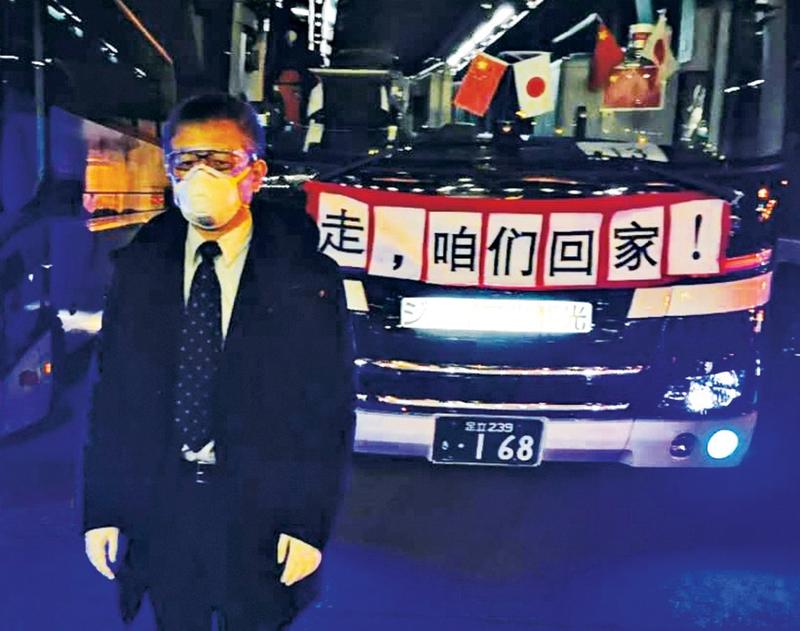 Zhan Kongchao, consul general of the Chinese embassy in Tokyo, stands in front of one of the shuttle buses to take the Hong Kong passengers on board Diamond Princess cruise ship to Haneda airport. (PHOTO PROVIDED TO CHINA DAILY)
Zhan Kongchao, consul general of the Chinese embassy in Tokyo, stands in front of one of the shuttle buses to take the Hong Kong passengers on board Diamond Princess cruise ship to Haneda airport. (PHOTO PROVIDED TO CHINA DAILY)
At 4:45 am Thursday morning, Zhan Kongchao, consul general of the Chinese embassy in Tokyo finally got a moment’s break from a hectic schedule after an aircraft chartered by the HKSAR government finally left Haneda airport, carrying the first 106 Hong Kong passengers from the virus-stricken Diamond Princess cruise ship back home.
After being stuck on the quarantined vessel at Yokohama port for more than two weeks, the 106 passengers, who had tested negative for the coronavirus, were given the all-clear by the Japanese authorities — survivors from the Diamond Princess, branded by some scientists as an “incubator” for the novel coronavirus.
Before their departure, seven hours had passed since the first of the passengers disembarked from the vessel at about 9 pm on Wednesday evening. Zhan couldn’t recall how many people he had talked to or called during the seven-hour wait.
If not for the common objective — sending as many people as possible back home as soon as possible — our team could not have cooperated so well and, definitely, couldn’t have completed the task
Zhan Kongchao, consul general of the Chinese embassy in Tokyo
“The most difficult part of the job is not the endless confirmation and communication, but that you had to switch back and forth at least from Mandarin, Cantonese, Japanese and English to get the job done,” Zhan said as he yawned, struggling to catch up with a mere two-hour sleep.
“If not for the common objective — sending as many people as possible back home as soon as possible — our team could not have cooperated so well and, definitely, couldn’t have completed the task,” he said.
The team Zhan referred to, however, is not really a team with a clear subordinate relationship or an accurate division of tasks. It’s just a temporary working group set up on Tuesday, comprising people from various parties, such as the Chinese embassy in Japan, the Office of the Commissioner of the Ministry of Foreign Affairs in the HKSAR, the Hong Kong Special Administrative Region government and the Hong Kong Economic and Trade Office in Tokyo.
“Our time was so limited and we don’t even have the chance to get to know each other better or remember their names before the work started,” he said.
According to Zhan, everyone in the team had to use his or her resources to the fullest because there just weren’t enough people to do it.
“Everyone showed the expertise required in the process. For example, people from Hong Kong were in charge of getting in touch with every passenger on board because most of them are from Hong Kong and are elderly people who can speak only Cantonese.”
According to Japan’s health ministry, there were a total of 414 Chinese on board the Diamond Princess — 21 from the mainland, 364 from Hong Kong, five from Macao and 24 from Taiwan. At least one passenger from the mainland, 55 from Hong Kong and one from Taiwan have been diagnosed with the coronavirus.
“For us, we helped to communicate with the Japanese side to pressure them to complete the medical tests for all the Chinese and give us early feedbacks,” Zhan said, adding the job is not always smooth as many people may think.
“We had a hard time getting shuttle buses to take the passengers to the airport because, you know, many companies are worried about their employees getting infected.”
The answer came as Zhan’s desperation grew. An overseas Chinese got in touch with Zhan, offering 13 buses to take the stranded Hong Kong passengers from the vessel to Haneda airport.
“It’s times like these that made me and people around me value the bonds of the Chinese community and Chinese culture,” said Zhan.
Constance Choy, who’s attached to the Hong Kong Economic and Trade Office in Tokyo, said people like Zhan and others from the Chinese embassy had been working with them from the very beginning, and their “efficiency and professionalism really helped a lot”.
The 106 Hong Kong passengers were the first group to be flown back to the SAR. A second chartered aircraft is standing by at Haneda airport ready to fly the rest of the Hong Kong residents home on Friday.
Among the 362 Hong Kong passengers on board the cruise ship, 55 of them have so far tested positive for the coronavirus and will have to remain in Japan along with 33 others who have had close contact with them.


